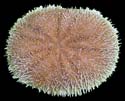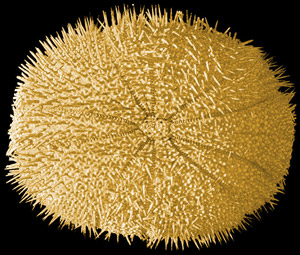Echinoneus cyclostomus, also called the little burrowing  urchin or round-mouth bean urchin, is a rather small “irregular” sea urchin. Its spines are short and range from whitish to light brown in color. The tube feet are conspicuously red, and can be found in narrow bands in the ambulacra. The color of the test is white to light brown. The mouth is ovoidal and located in the center of the oral surface of the test. A large anus can be found just posterior to the mouth. Echinoneus cyclostomus ingests organic material that adheres to coarse sand and shell fragments. Adult individuals of this species and others in the family Echinoneidae do not possess a lantern or teeth – these structures are absorbed during maturation. urchin or round-mouth bean urchin, is a rather small “irregular” sea urchin. Its spines are short and range from whitish to light brown in color. The tube feet are conspicuously red, and can be found in narrow bands in the ambulacra. The color of the test is white to light brown. The mouth is ovoidal and located in the center of the oral surface of the test. A large anus can be found just posterior to the mouth. Echinoneus cyclostomus ingests organic material that adheres to coarse sand and shell fragments. Adult individuals of this species and others in the family Echinoneidae do not possess a lantern or teeth – these structures are absorbed during maturation.
The little burrowing urchin occurs woldwide throughout the tropics. It inhabits waters 5-570 m in depth, but is most common at shallow depths. Echinoneus cyclostomus can be found under rock slabs or pieces of coral rubble, living in or on coarse sand. The urchin is never exposed; it may burrow or cling to undersurfaces of rock slabs. It is generally sedentary and moves very slowly even when disturbed.
 |
Click on the thumbnail to the left for an illustration of the basic morphology of Echinoneus. |

About the Species
This specimen was collected in 1969 by Dr. J.D. Taylor on Aldabra. Aldabra is the biggest atoll found in the Indian Ocean. It belongs politically to the Seychelles and was named a UNESCO World Heritage Site. Dr. Taylor, a specialist for intertidal ecology working at the Zoology Department of the NHM at that time, visited the island twice, in 1969 and 1973. During his stay between June and September 1969 he collected and fixed the specimen used in this scan. The specimen is part of the marine invertebrates wet collection of the NHM.
The specimen was scanned for Dr. Alexander Ziegler of Freie Universitaet Berlin.

About this Specimen
This specimen was scanned in May 2007 by Mr. Heiko Temming at the Max-Planck-Institut für evolutionäre Anthropologie using a SkyScan 1172. The isotropic voxels measure 0.01739 mm.

About the
Scan
Literature
Hendler, G., J. E. Miller, D. L. Pawson, and P. M. Kier. 1995. Sea Stars, Sea Urchins, and Allies: Echinoderms of Florida and the Caribbean. Washington, D.C., Smithsonian Institution Press, 390 p.
Mortensen, T. 1928-1951. A Monograph of the Echinoidea. Copenhagen, C.A. Reitzel.
Schultz, H. 2006. Sea Urchins, a guide to worldwide shallow water species. Augsburg, Scientific Publications, 484 p.
Links
Echinoneus page on The Echinoid Directory (Natural History Museum, London)

Literature
& Links
Front page image.
|  |

Additional
Imagery
|










